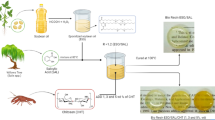Abstract
In order to facilitate the application of bio-based resins in more demanding advanced sectors as electrical and aeronautical industry, a systematic study was carried out to characterize the effect of epoxidized soybean oil (ESO), one of the most commonly used bio-based resins, on curing and rheological behavior, glass transition temperature, mechanical and thermal properties in various epoxy resin systems. Besides the conventional, widely investigated aromatic diglycidylether of bisphenol-A (DGEBA) resin, a glycerol- and a pentaerythritol-based aliphatic resin was chosen as base resin, whose synthesis is feasible from renewable materials as well, in the end leading to full replacement of mineral oil based resins by renewable sourced ones. In the hybrid resin system the ESO content was systematically increased from 0 to 100 mass%. The results indicate that in the case of the DGEBA containing hybrid systems the overall performance deteriorates with increasing ESO-content, while in the case of the aliphatic resins the glass transition temperature increases.









Similar content being viewed by others
References
Raquez J-M, Deléglise M, Lacrampe M-F, Krawczak P (2010) Prog Polym Sci 35:487
Liu XQ, Huang W, Jiang YH, Zhu J, Zhang CZ (2012) Express Polym Lett 6:293
Sarwono A, Man Z, Bustam MA (2012) J Polym Environ 20:540
Güner FS, Yagci Y, Erciyes AT (2006) Prog Polym Sci 31:633
Tan SG, Chow WS (2010) Polym Plast Technol 49:1581
Wang R, Schuman TP (2013) Express Polym Lett 7:272
Ratna D (2001) Polym Int 50:179
Zhu J, Chandrashekhara K, Flanigan V, Kapila S (2004) J Appl Polym Sci 91:3513
Earls JD, White JE, López LC, Lysenko Z, Dettloff ML, Null MJ (2007) Polymer 48:712
Li J, Du Z, Li H, Zhang C (2009) Polymer 50:1526
Mustata F, Tudorachi N, Rosu D (2011) Compos B 42:1803
Park S-J, Jin F-L, Lee J-R (2004) Mat Sci Eng A 374:109
Park S-J, Jin F-L, Lee J-R (2004) Macromol Chem Phys 205:2048
Gerbase AE, Petzhold CL, Costa APO (2002) J Am Oil Chem Soc 79:797
Miyagawa H, Misra M, Drzal LT (2005) Polym Eng Sci 45:487
Altuna FI, Espósito LH, Ruseckaite RA, Stefani PM (2011) J Appl Polym Sci 120:789
Gupta AP, Ahmad S, Dev A (2011) Polym Eng Sci 51:1087
Karger-Kocsis J, Grishchuk S, Sorochynska L, Rong MZ (2013) Polym Eng Sci 54:747
Kim JR, Sharma S (2012) Ind Crop Prod 36:485
Jin F-L, Park S-J (2007) J Ind Eng Chem 13:808
Acknowledgments
The research leading to these results has received funding from the European Union’s Seventh Framework Programme (FP7/2007-2013) for the Clean Sky Joint Technology Initiative under Grant Agreement No 298090. This work is connected to the scientific program of the “Development of quality-oriented and harmonized R + D + I strategy and functional model at BME” project. This project is supported by the New Széchenyi Plan (Project ID: TÁMOP-4.2.1/B-09/1/KMR-2010-0002) and by the NFÜ EU_BONUS_12-1-2012-0026. The work reported in this paper has been developed in the framework of the project “Talent care and cultivation in the scientific workshops of BME” project. This project is supported by the grant TÁMOP-4.2.2.B-10/1–2010-0009. Andrea Toldy acknowledges the financial support received through János Bolyai Scholarship of the Hungarian Academy of Science.
Author information
Authors and Affiliations
Corresponding author
Rights and permissions
About this article
Cite this article
Niedermann, P., Szebényi, G. & Toldy, A. Effect of Epoxidized Soybean Oil on Curing, Rheological, Mechanical and Thermal Properties of Aromatic and Aliphatic Epoxy Resins. J Polym Environ 22, 525–536 (2014). https://doi.org/10.1007/s10924-014-0673-8
Published:
Issue Date:
DOI: https://doi.org/10.1007/s10924-014-0673-8




